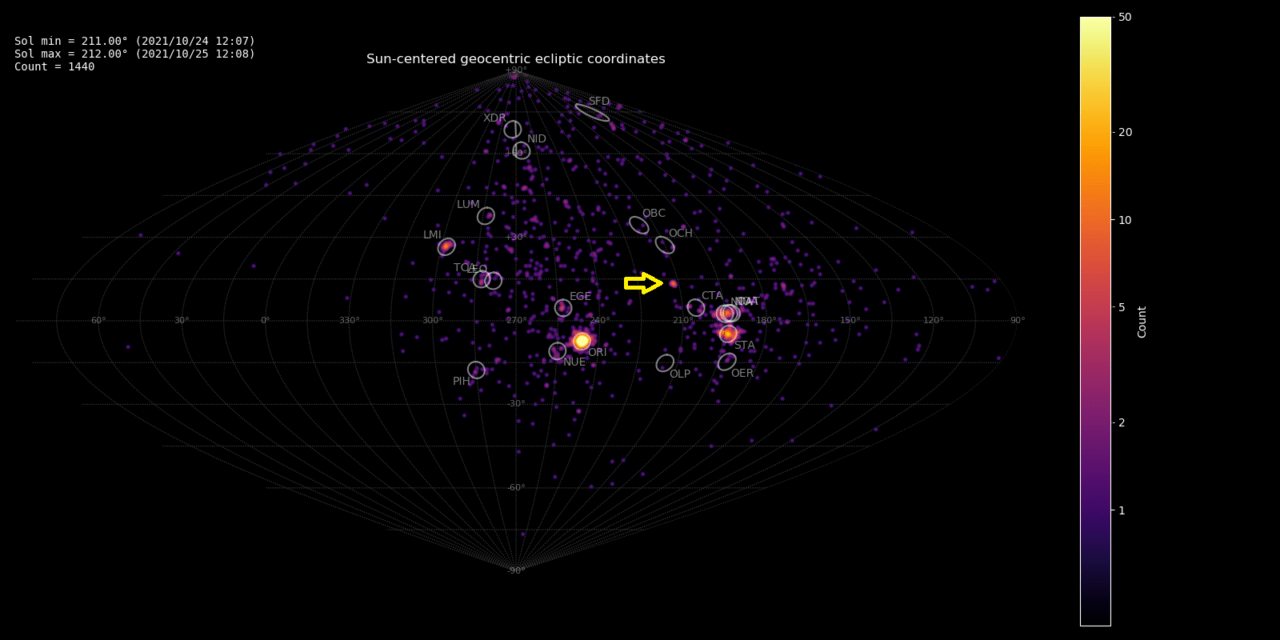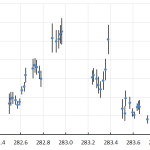By Denis Vida, Damir Šegon, and Paul Roggemans
Abstract: A new long-period meteor shower has been discovered by the Global Meteor Network. The shower experienced a sharp outburst at solar longitude 211.36°, and the peak lasted ~30 min. The median radiant is at R.A. = 58.19°, Decl. = +33.72°, geocentric velocity was vg = 48.1 ± 0.8 km/s.
1 Introduction
During the night of 2021 October 24–25, more than 500 low-light video cameras of the Global Meteor Network monitored meteor activity worldwide when some unexpected short-lived outburst occurred with a radiant in the constellation of Perseus. The radiant appeared on the radiant plot (Figure 1) once the reduction pipeline with the available uploaded camera data was completed. A preliminary investigation was made to verify the origin and nature of these orbits. Obviously, a previously unknown and peculiar meteoroid stream had encountered the Earth.
The shower was independently observed by cameras in 7 different countries (Czechia, Germany, Spain, France, Croatia, the Netherlands, and the UK). The first meteor was observed on Oct 24 at 19h10m UTC, and the last one at 22h13m UTC. The main bulk of activity was between 20h30m and 21h00m UTC. The skies were clear before and after, so more would be observed if there were any.
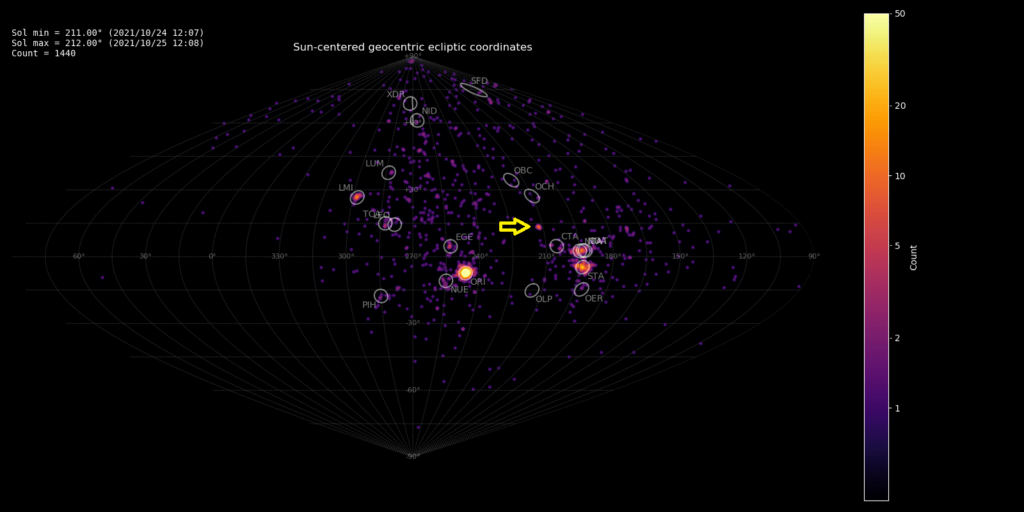
Figure 1 – The unexpected radiant appears as a compact dot at the Sun centered geocentric ecliptic coordinates λ – λʘ = 212°, β = 13.5° on this plot (just above and left of CTA) marked with the yellow arrow.
2 Observational data
In total 14 meteors were recorded for this new shower. The meteors (all brighter than magnitude 0) had a median radiant with coordinates R.A. = 58.19°, Decl. = +33.72°, within a circle with the standard deviation of ± 0.52° (equinox J2000.0). The median Sun-centered ecliptic coordinates were λ – λʘ = 211.86°, β = +13.16° (Figure 2). The geocentric velocity was vg = 48.1 ± 0.8 km/s. The mean radiant scatter (standard deviation of offsets from the median radiant) was only 0.52°.
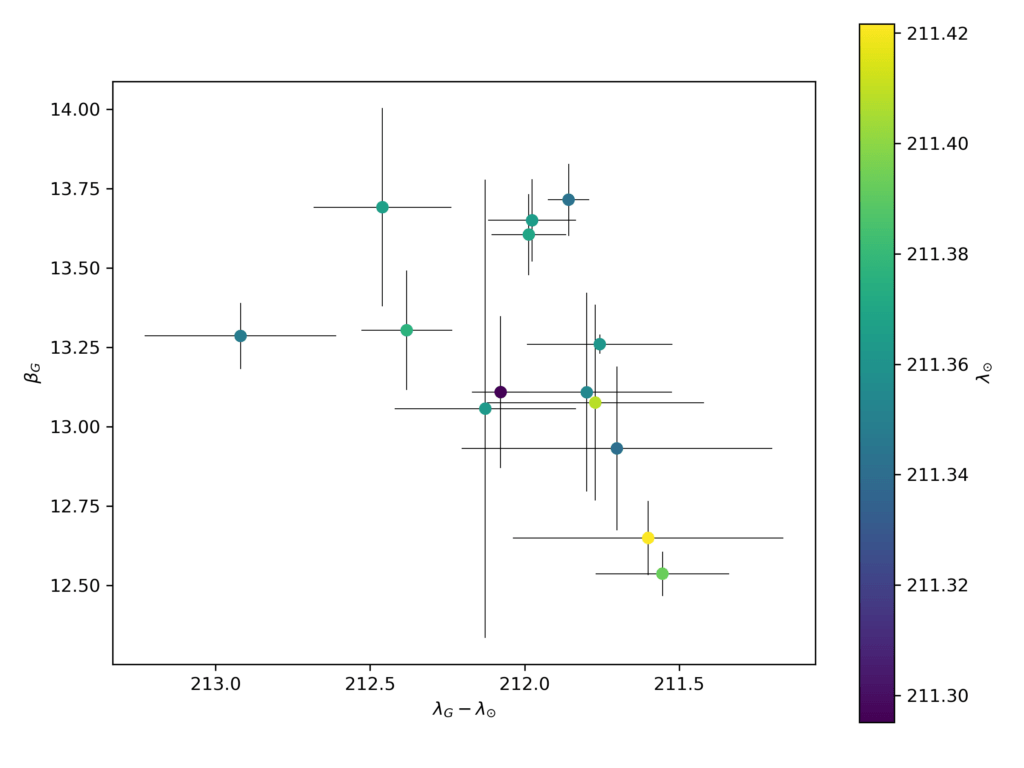
Figure 2 – The radiant distribution in Sun-centred ecliptic coordinates, together with the error bars.
The orbital elements (equinox J2000.0) are those of a sunskirting long-period comet:
- q = 0.082 ± 0.003 AU
- e = 0.998 ± 0.005
- i = 65.2 ± 2.5°
- ω = 326.8 ± 0.8°
- Ω = 211.377 ± 0.030°
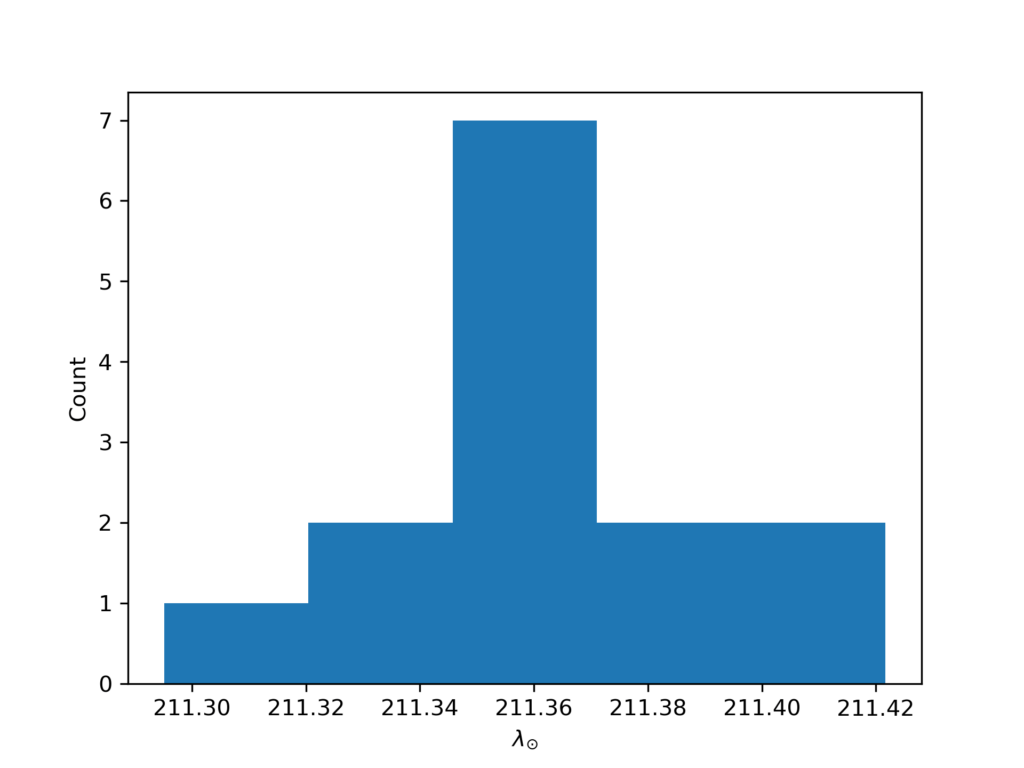
Figure 3 – There was a very sharp peak in activity centred at λʘ = 211.36°.
All meteors appeared during the solar-longitude interval 211.30°–211.42°, with a sharp peak at 211.36°. 50% of meteors were observed in 30 minutes, while the whole activity lasted 3 hours (Figure 3).
The parent body search did not return any candidates (see Table 1). The shower is now listed as number 1131 in the IAU MDC shower database (Jenniskens et al., 2020; Jopek and Kaňuchová, 2017; Jopek and Jenniskens, 2011; Neslušan et al., 2020) and named the October zeta Perseids (OZP). GMN images are shown in Figures 4 to 12.
Table 1 – The top 5 matched sorted by the similarity criteria DSH (Southworth and Hawkins, 1963).
| Name | q | e | i | ω | Ω | DSH |
| C/2004 F4 (Bradfield) | 0.168 | 0.999 | 63.16 | 332.786 | 222.778 | 0.28 |
| C/2012 T5 (Bressi) | 0.323 | 1.000 | 72.10 | 318.094 | 230.594 | 0.41 |
| C/1786 P1 (Herschel) | 0.411 | 1.000 | 50.89 | 325.052 | 197.400 | 0.49 |
| C/1987 W1 (Ichimura) | 0.200 | 1.000 | 41.62 | 329.293 | 226.528 | 0.51 |
| C/1997 V9 (SOHO) | 0.061 | 1.000 | 93.76 | 316.920 | 219.170 | 0.53 |
Figure 4 – October zeta Perseid 2021, October 24, 20h16m07.8s UT on CZ0003 at Prague, Czech Republic. (Operator Milan Kalina).
Figure 5 – October zeta Perseid 2021, October 24, 20h16m07.8s UT on HR000M at Đakovo, Croatia. (Operator Danko Kočiš).
Figure 6 – October zeta Perseid 2021, October 24, 20h16m07.8s UT on HR001Z at Hum, Croatia. (Operator Aleksandar Merlak).
Figure 7– October zeta Perseid 2021, October 24, 20h35m42.1s UT on NL000B at Hengelo, Netherlands. (Photo: Martin Breukers).
Figure 8 – October zeta Perseid 2021, October 24, 20h57m29.6s UT on HR000D at Čiovo, Croatia. (Operator Josip Belas).
Figure 9 – October zeta Perseid 2021, October 24, 20h57m29.6s UT on HR000K at Zvjezdano selo Mosor, Croatia. (Operator Zoran Knez).
Figure 10 – October zeta Perseid 2021, October 24, 20h57m29.6s UT on HR000M at Đakovo, Croatia. (Operator Danko Kočiš).
Figure 11 – October zeta Perseid 2021, October 24, 20h57m29.6s UT on HR000P at Požega, Croatia. (Operator Nikola Gotovac).
Figure 12 – October zeta Perseid 2021, October 24, 20h57m29.6s UT on HR000S at Virovitica, Croatia. (Operator Danijel Reponj).
3 Independent confirmation
CAMS BeNeLux coordinator Martin Breukers checked the available camera data for this network. A preliminary reduction of the night October 24–25 resulted in about 650 orbits. Only two matching orbits were found with a mean orbit at:
- q = 0.077 AU
- e = 0.994
- i = 68.6°
- ω = 328.21°
- Ω = 211.35°
Both meteors appeared on October 24, at 20h21m10s UT (λʘ = 211.344°) (Figure 13) and at 20h40m18s UT (λʘ = 211.357°) (Figure 14) registered by the same cameras stationed in Mechelen (Belgium) and Wilderen (Belgium). It is likely that more candidates may be found once all stations have reported their data. So far, no other CAMS networks detected any meteors from the new meteor shower because either daylight or bad weather interfered.
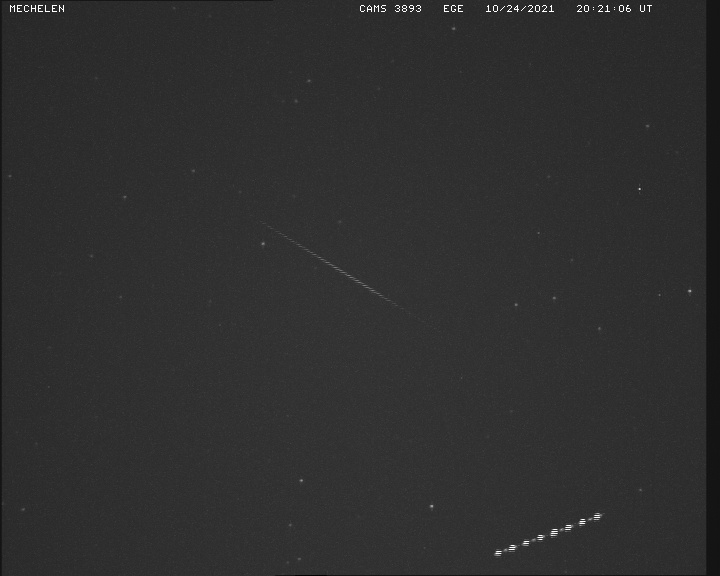
Figure 13 – October zeta Perseid 2021, October 24, 20h21m10s UT. CAMS Watec 3893 at Mechelen, Belgium (photo Luc Gobin).
Figure 14 – October zeta Perseid 2021, October 24, 20h40m18s UT. CAMS Watec 379 at Wilderen, Belgium (photo Jean-Marie Biets).
A search among 1326006 orbits collected by CAMS, EDMOND, SonotaCo and Global Meteor Network before 2021, resulted in 20 similar orbits, using the mean orbit for the 14 GMN orbits mentioned above as reference orbit. No significant activity has been detected in previous years. The 20 similar orbits are listed in Table 2, although the connection still needs to be confirmed.
Table 2 – List with 20 possible past detections of October zeta Perseid meteors, DD is the similarity criteria according to Drummond (1981).
| Ref. | MetCod | λ–λʘ (°) | βg (°) | vg | q (AU) | e | i (°) | Ω (°) | ω (°) | DD |
| CAMS1 | 20111028_095057 | 212.493 | 14.57 | 48.15 | 0.0955 | 0.9965 | 67.82 | 214.46 | 324.19 | 0.08 |
| CAMS1 | 20131025_050721 | 210.396 | 12.78 | 48.01 | 0.0844 | 1.0034 | 59.58 | 211.76 | 325.80 | 0.04 |
| CAMS1 | 20141024_131029 | 215.153 | 13.48 | 49.06 | 0.0767 | 0.9924 | 77.80 | 210.85 | 328.53 | 0.09 |
| CAMS3 | 20151101_002811 | 211.643 | 13.22 | 47.00 | 0.0844 | 0.9919 | 60.90 | 218.04 | 326.87 | 0.05 |
| CAMS3 | 20161022_194340 | 211.040 | 13.40 | 46.04 | 0.0900 | 0.9883 | 57.39 | 209.61 | 326.07 | 0.07 |
| CAMS3 | 20161101_220616 | 211.990 | 14.25 | 46.56 | 0.0943 | 0.9872 | 61.93 | 219.69 | 325.26 | 0.09 |
| CAMS7 | 20161030_163130 | 211.850 | 14.54 | 47.28 | 0.0976 | 0.9928 | 63.79 | 217.45 | 324.09 | 0.09 |
| CAMS7 | 20161031_001752 | 213.086 | 14.31 | 47.17 | 0.0904 | 0.9873 | 66.57 | 217.78 | 326.07 | 0.07 |
| SON | 20071023_195831 | 210.629 | 13.98 | 46.42 | 0.0977 | 0.9924 | 58.14 | 209.92 | 324.15 | 0.10 |
| SON | 20081028_122944 | 212.057 | 14.00 | 48.53 | 0.0905 | 1.0006 | 66.93 | 215.34 | 324.81 | 0.06 |
| SON | 20081101_200903 | 211.815 | 13.43 | 44.52 | 0.0891 | 0.9757 | 55.17 | 219.66 | 327.47 | 0.09 |
| SON | 20121029_134257 | 211.842 | 13.32 | 50.64 | 0.0839 | 1.0148 | 71.19 | 216.37 | 324.86 | 0.06 |
| SON | 20181028_130055 | 212.455 | 14.38 | 47.85 | 0.0932 | 0.9944 | 66.81 | 214.80 | 324.83 | 0.07 |
| SON | 20191022_154529 | 222.225 | 16.00 | 40.37 | 0.0803 | 0.9284 | 70.91 | 208.67 | 335.44 | 0.07 |
| EUS | 20141012_233039 | 212.718 | 13.92 | 46.09 | 0.0877 | 0.9832 | 62.97 | 199.36 | 327.12 | 0.09 |
| EUS | 20141018_004842 | 215.789 | 15.34 | 46.70 | 0.0937 | 0.9740 | 73.95 | 204.36 | 326.72 | 0.09 |
| EUS | 20151024_182441 | 212.531 | 13.48 | 48.14 | 0.0830 | 0.9963 | 67.03 | 210.81 | 326.78 | 0.01 |
| EUS | 20151027_195358 | 210.190 | 13.37 | 48.25 | 0.0914 | 1.0065 | 60.36 | 213.86 | 324.11 | 0.06 |
| SON | 20201024_141728 | 213.148 | 12.80 | 48.64 | 0.0738 | 0.9970 | 69.59 | 211.35 | 328.69 | 0.06 |
| SON | 20201024_165630 | 214.240 | 13.49 | 47.25 | 0.0776 | 0.9855 | 69.64 | 211.46 | 329.04 | 0.04 |
Acknowledgment
The authors thank all participants in the Global Meteor Network community for their commitment and efforts to operate their cameras. Without their efforts this remarkable meteor shower would have passed probably completely unnoticed.
References
Drummond J. D. (1981). “A test of comet and meteor shower associations”. Icarus, 45, 545–553.
Jenniskens P., Jopek T.J., Janches D., Hajduková M., Kokhirova G.I., Rudawska R. (2020). “On removing showers from the IAU Working List of Meteor Showers”. Planetary and Space Science, 182, id. 104821.
Jopek T. J. and Kaňuchová Z. (2017). “IAU Meteor Data Center – the shower database: A status report”. Planetary and Space Science, 143, 3–6.
Jopek T. J. and Jenniskens P. M. (2011). “The Working Group on Meteor Showers Nomenclature: A History, Current Status and a Call for Contributions”. In Meteoroids: The Smallest Solar System Bodies, Proceedings of the Meteoroids Conference held in Breckenridge, Colorado, USA, May 24-28, 2010. Edited by W.J. Cooke, D.E. Moser, B.F. Hardin, and D. Janches, NASA/CP-2011-216469., 7–13.
Neslušan L., Poručan V., Svoreň J., Jakubík M. (2020). “On the new design othe IAU MDC portal”. WGN, Journal of the International Meteor Organization, 48, 168–169.
Southworth R. R. and Hawkins G. S. (1963). “Statistics of meteor streams”. Smithson. Contrib. Astrophys., 7, 261–286.

